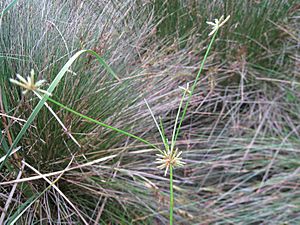Isolepis prolifera facts for kids
Quick facts for kids Isolepis prolifera |
|
|---|---|
 |
|
| Conservation status | |
| Scientific classification | |
| Genus: |
Isolepis
|
| Species: |
prolifera
|
| Synonyms | |
|
|
Isolepis prolifera is a flowering plant that belongs to the sedge family, called Cyperaceae. It grows in many places in the Southern Hemisphere, which is the bottom half of the Earth. This plant has tall, leafless stems that can reach up to 90 centimeters (about 3 feet) high. Its flowers grow in small groups that often sprout into new branches. This special way of growing gives the plant its scientific name, prolifera.
What Does It Look Like?
Isolepis prolifera grows in a tufted way, meaning it forms clumps. Its stems are round and can be up to 90 cm tall and 4 mm wide. Instead of regular leaves, it has small red or brown covers around its stem. Sometimes, these covers have a tiny free tip, only about 3 mm long.
The plant's flowers are grouped together in small clusters called spikelets. These spikelets are usually 2 to 10 mm long and 1 to 2 mm wide. Many of these flower clusters don't just have flowers. Instead, they grow into new branches, each 2 to 7 cm long. These new branches then have their own flower clusters at their ends. This unique branching habit is why it's called prolifera, which means "producing offspring" or "proliferating" in Latin. Each spikelet can have up to 30 flowers. The fruit of the plant is a tiny nutlet with a fine, net-like pattern on its surface.
Isolepis prolifera can look very different in size. Smaller plants might look a bit like another plant from Australia and New Zealand called Isolepis inundata. However, I. inundata usually has some real leaves and doesn't always grow new branches from its flower clusters.
Where Does It Grow?
Isolepis prolifera is found in many countries around the world. Scientists are still figuring out exactly where it originally came from. It's not always clear if it's a native plant (meaning it grew there naturally) or an introduced species (meaning people brought it there).
The International Union for Conservation of Nature (IUCN) believes it is native only to South Africa. There, it grows in the Eastern Cape, KwaZulu-Natal, and Western Cape provinces. It is also very common in New Zealand, found on the South Island, North Island, and the Chatham Islands. It might be native there too.
In Australia, you can find I. prolifera in New South Wales, Victoria, and Tasmania. It also grows in the Mediterranean-like climate of Western Australia. This plant might also be native to Tristan da Cunha and Saint Helena. It has been introduced to places like France and California by people.
How It Lives and Grows
Isolepis prolifera is a perennial plant, which means it lives for more than two years. It grows as a marsh plant, loving wet environments. It can grow well in different types of wetlands. It thrives in both wetlands that are rich in nutrients (called eutrophic) and those that have fewer nutrients (called oligotrophic). Sometimes, it can even grow as a weed in farm drainage areas.
What's in a Name?
The plant Isolepis prolifera was first described by a scientist named Christen Friis Rottbøll in 1772. He was a student of the famous botanist Carl Linnaeus. Rottbøll first named it "Scirpus prolifer".
Later, in 1810, another scientist named Robert Brown moved it to the genus Isolepis. However, some scientists think it's quite different from other Isolepis species. They believe it might fit better in a different group, like Scirpoides.
Isolepis prolifera has different common names depending on where you are. In South Africa, it's called vleigras in Afrikaans or incapha in Zulu. In Australia, people call it "budding club-rush." In the United States, it's known as "proliferating bulrush." In New Zealand, it sometimes doesn't have a common name, or it's called "three-square."


